The Baked Samosa Recipe is a wonderful twist to a classic Indian snack that is commonly deep-fried. Homemade flaky pastry made with whole wheat flour encases spicy sweet potatoes with peas. Its crispy golden perfection due to the baking process makes it much lighter than its deep-fried counterpart. These samosas are so irresistible that you can enjoy them as an appetizer, snack, or any time of the day. They have a satisfying crunch you will savor when served with tangy tamarind and some refreshing mint chutneys!
The classic Indian snack is the samosa. Served with tea (chai) or coffee, this dough-filled pastry has a myriad of crusts and fillings. They tend to be pyramidal or triangular with a delicious bulge in the center or even crescent-shaped.
The Baked Samosa Recipe is the convenient staple of travelers, can be purchased at almost any chai shop, is a regular affair at train stations and airports, serves as hors d’oeuvre at glamorous parties, and is common at almost any hotel. I’d venture to guess that there is no more ubiquitous food in India than the humble samosa. One could even say, given the incredible medley of regional foods, that this may well be India’s national dish.
Virtually every Indian household has its traditions of how to make the samosa. My recipe below is a combination of what I learned helping my mother, and generally eating my way through various samosas everywhere. What I have learned is that it’s not just the filling but it’s all about the pastry. Every household and restaurant that makes samosas has its variations in developing the pastry crust. We all try to achieve that satisfying first “crunch” that typifies freshly made Baked Samosa. As for me, I have tried at least ten different ways of making the samosa over the years.
I relate to this story because the quality of my variation of the samosa has stood the test of time and audience. I will admit, that even using a food processor to bring the dough together, and then rolling it out can be time-consuming. The recipe for the Baked Samosa is made with a simple sweet potato filling, but I’ve also included other filling variations below. No matter which filling or method you use, what I can assure you is that based on the feedback from friends, and family, these snacks taste much better than the store-bought ones.
Origin:
You could argue that the history of the samosa in India is the history of India itself. Whether it was the Aryan migration, the trade routes to the Silk Road, the Mogul era, or even the British Raj, the samosa has migrated, adapted, and evolved to the point that many believe, as I once did, that the samosa is Indian in origin. The truth is that the samosa is proof that the concept of globalization is as old as humanity’s travels. If you would like to read more about the history and origins of the samosa, you can find it as I describe its Continental cousin, the Empanada. The Baked Samosa recipe is my creation to make this snack a healthy one.
Techniques to bake the samosas:
- The dough must be soft yet stiff. Adding too much water to make it like chapatis which will not yield good samosas. Use cold water to bring the dough together.
- This recipe does not require much kneading. Rub the fats into the flour and bring it together with some water.
- The fat must be rubbed into the flour to resemble bread crumbs. You must ensure that this step is done well for a few minutes.
- This snack is an indulgence, so do not cut back on the amount of fats. Fats yield a flaky crust.
- The dough must be rolled to an even thickness– not too thin or too thick. Too thin will make the filling pop out and too thick will result in uneven cooking of the crust.
Frequently Asked Questions:
- How do I deep fry the samosas? While deep frying the samosas, ensure that they are submerged in the oil. Heat the oil for 3 minutes on high, and then lower the heat as much as you can. Frying the samosas on very hot oil will result in blisters on the crust. It is important to be patient at this step. Deep fry them on very low heat. Once you remove them and drain, reheat the oil to medium and wait for a minute. Then, lower the heat again and gently slide the next batch of samosas into the oil. Take care while sliding the samosas into the wok or kadai. You do not want to drop them in but instead, slide using a slotted spoon. Deep fry two to three samosas at a time.
2. Can I air-fry the samosas?
Yes, you can air-fry the samosas. Air-fry them for 15- 20 minutes after brushing with oil. Check them halfway through cooking and flip them over for best results.
3. How can I vary the fillings?
- Veggie samosas – use the same spices and add chopped onions, carrots, French beans, peas, and potatoes
- Paneer – fry paneer cubes with the same spices
- Minced chicken or lamb (keema) – onion, minced lamb, peas, and the same spices
- Chicken – cook chicken with potato and the same spices
This post may contain affiliate links. As an Amazon Associate, I earn from qualifying purchases at no extra cost to you.
If you’ve tried this recipe or have questions, I would love to hear from you. Please feel free to share (below) your thoughts, comments, or any questions that you might have. And if you like my recipes, you could subscribe to my mailing list for the latest recipes that will be delivered to your inbox. From my pen to your table, Bon Appetit!
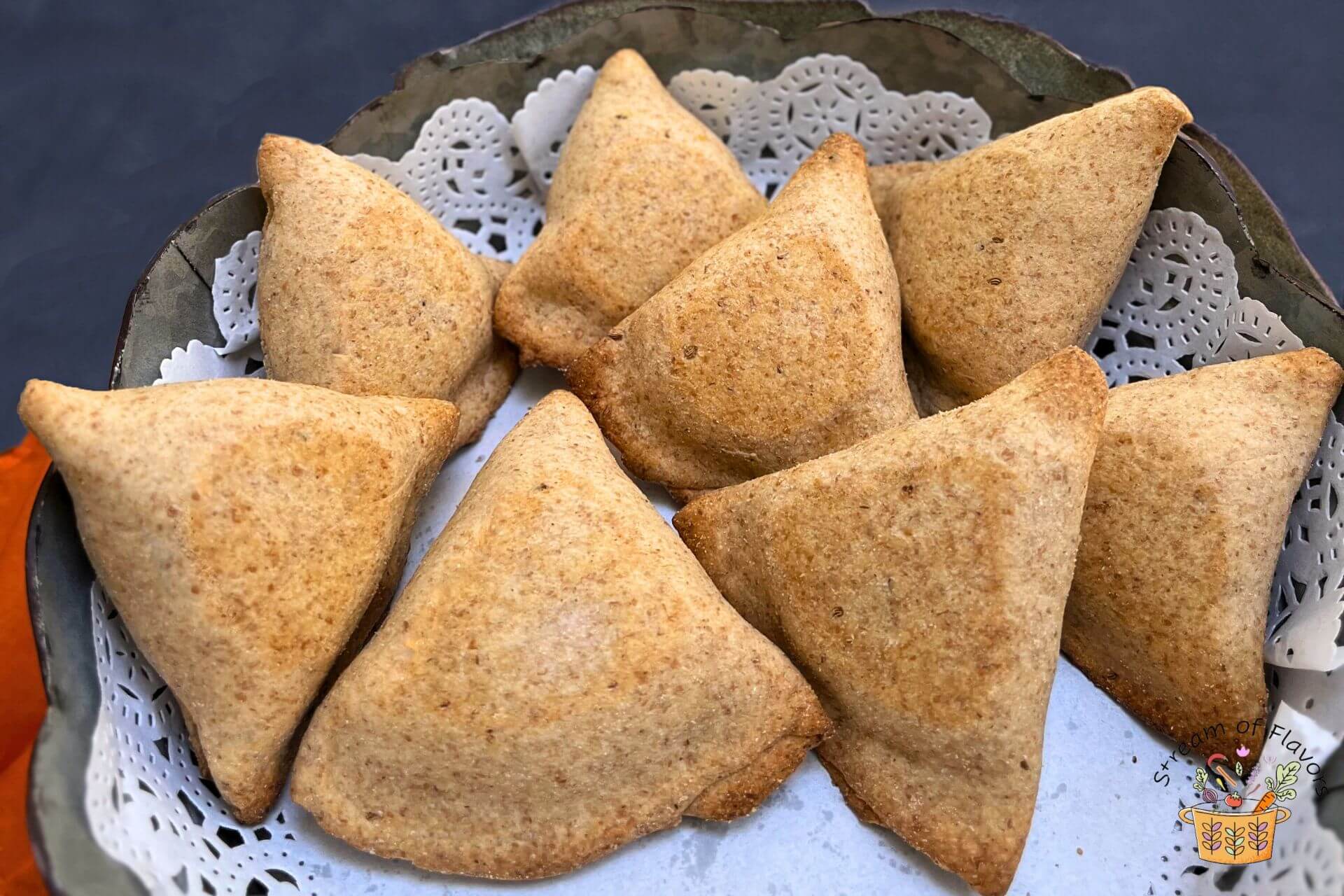
Ingredients:
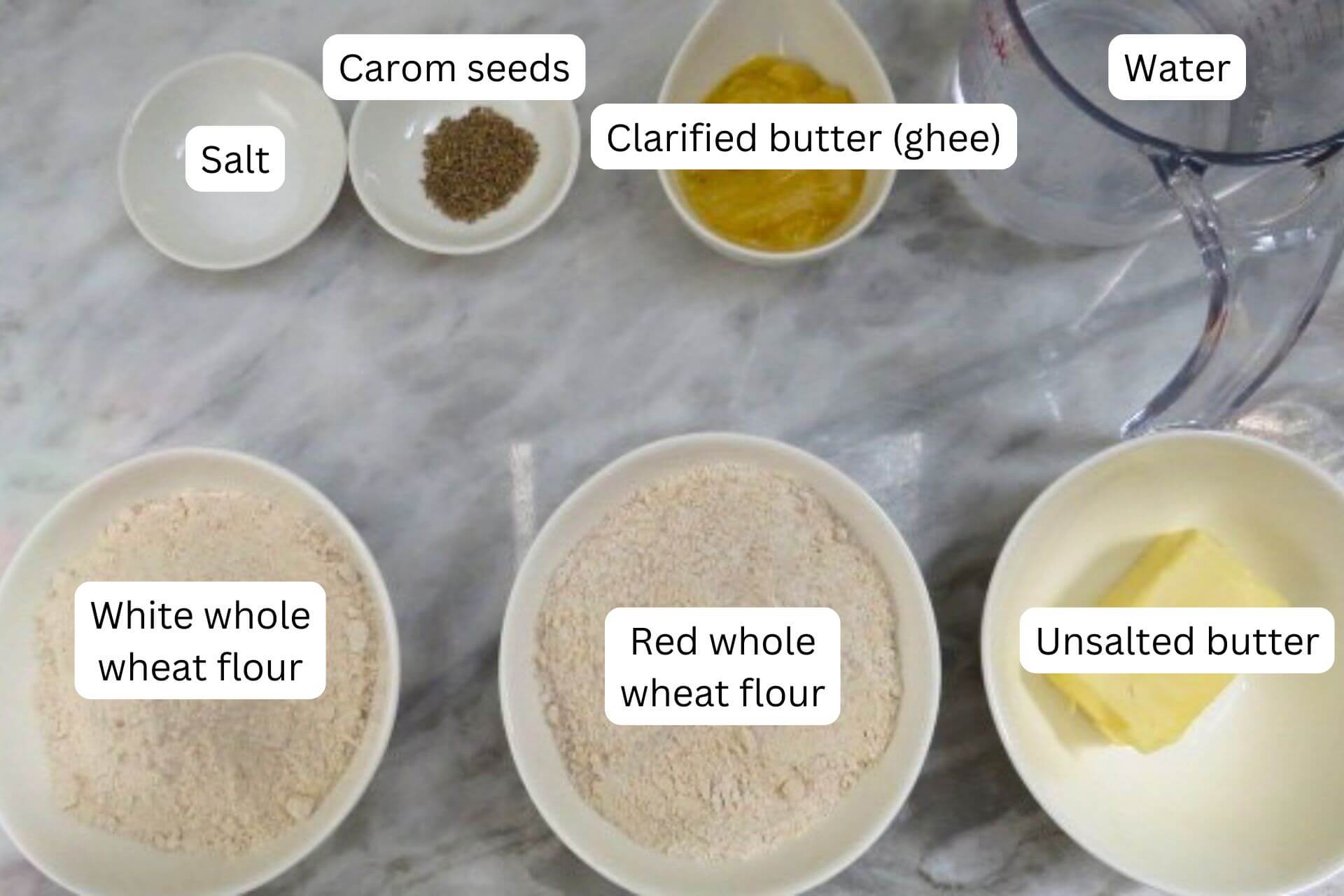
- Pastry: white whole wheat flour, red whole wheat flour, unsalted butter, clarified butter, and carom seeds; feel free to use just whole wheat flour and canal or sunflower oil.
- Filling: white sweet potato, ginger, spices, cashew nuts, lemon juice and olive oil for brushing
How to make the Baked Samosa using my recipe:
- How to make the samosa pastry:
- Add the flour, salt, ghee and butter to the food processor with the dough blade. Run the processor to ‘rub’ the fat into the flour until it resembles bread crumbs.
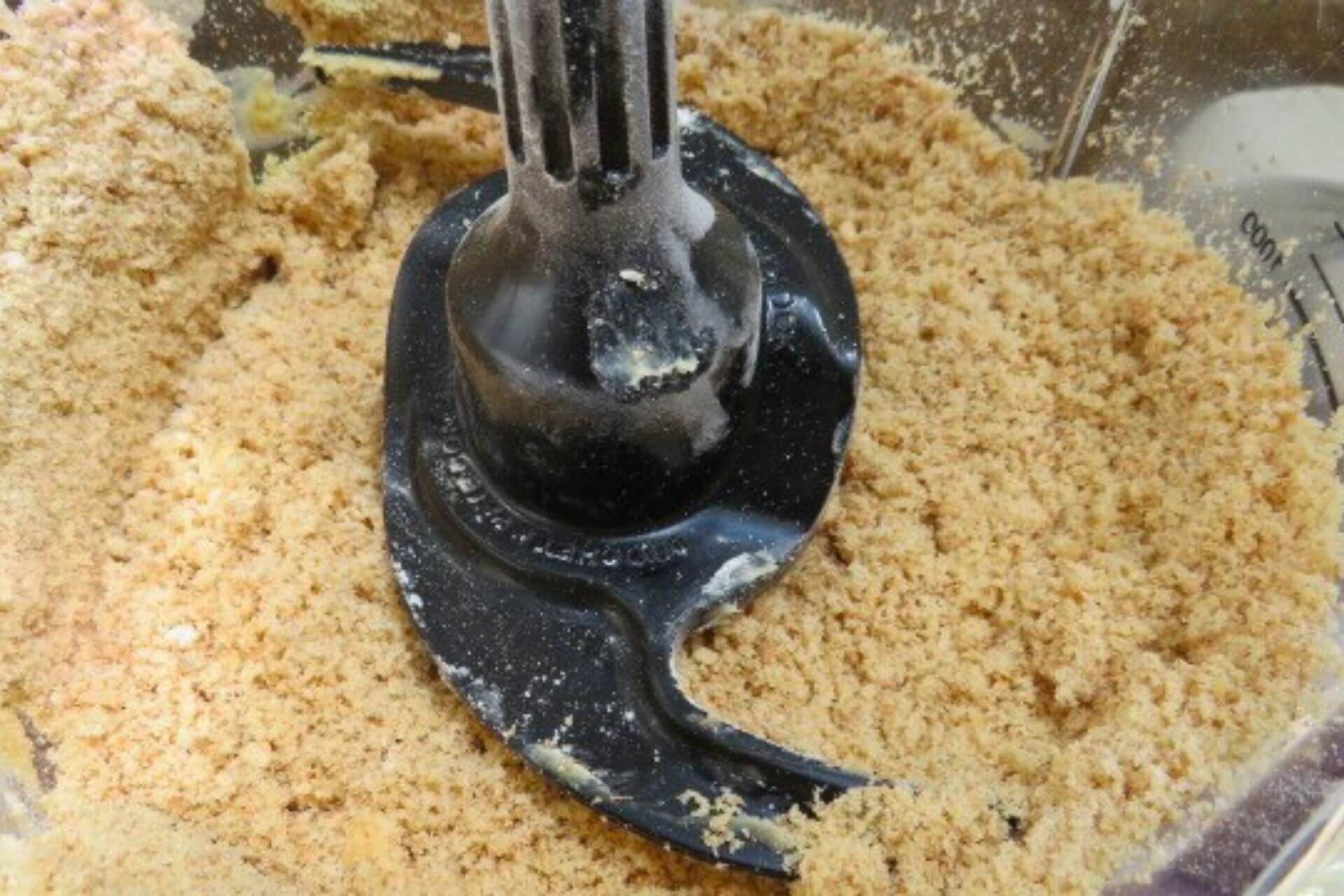
- Slowly add ice-cold water until it forms a firm dough. Cover with a damp kitchen towel and let the dough rest for 30 minutes.
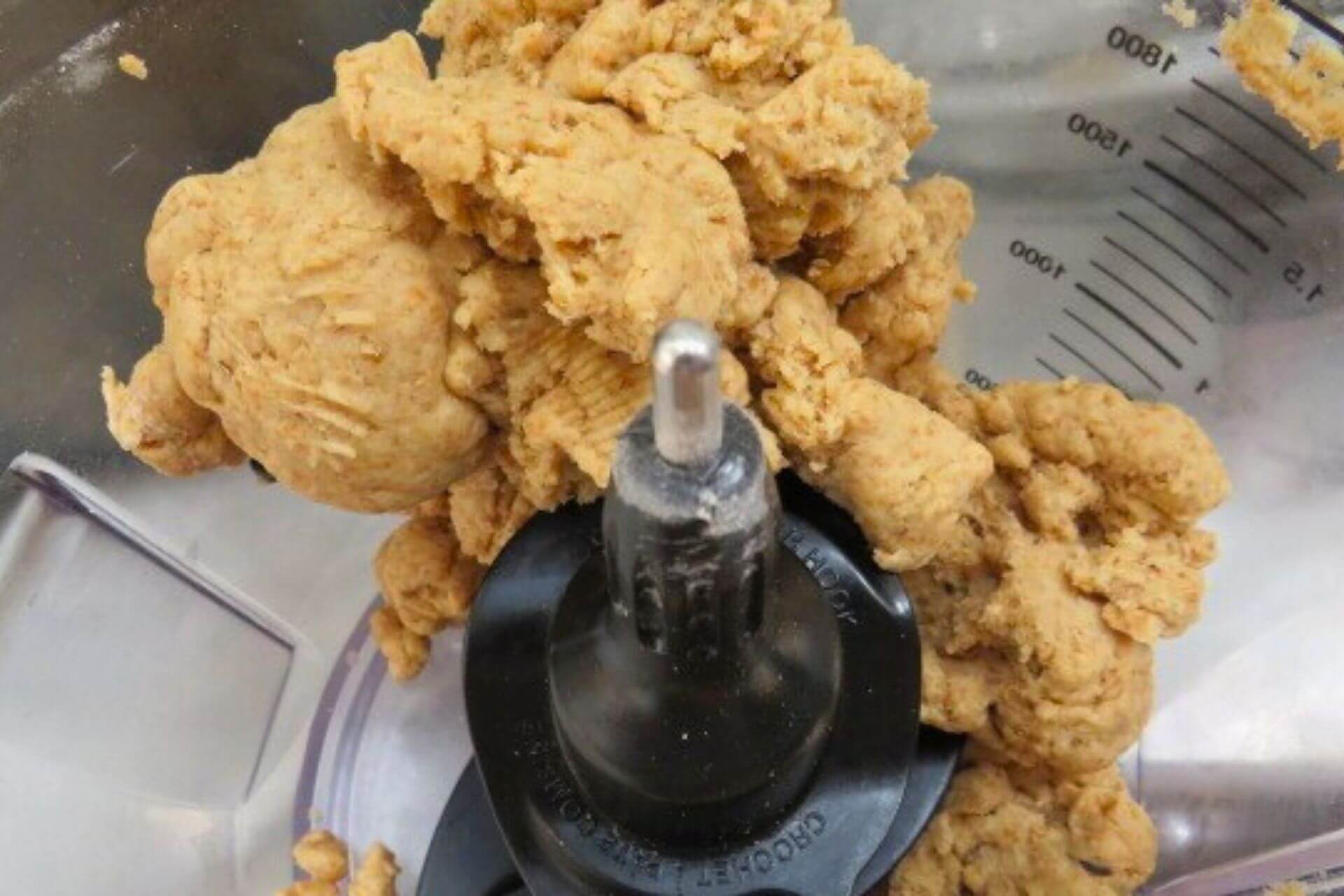
2. How to make the filling:
- Heat a pan with the olive oil. Sauté the ginger with asafetida for a few seconds. Add the onion and cashew nuts and sauté until lightly caramelized.
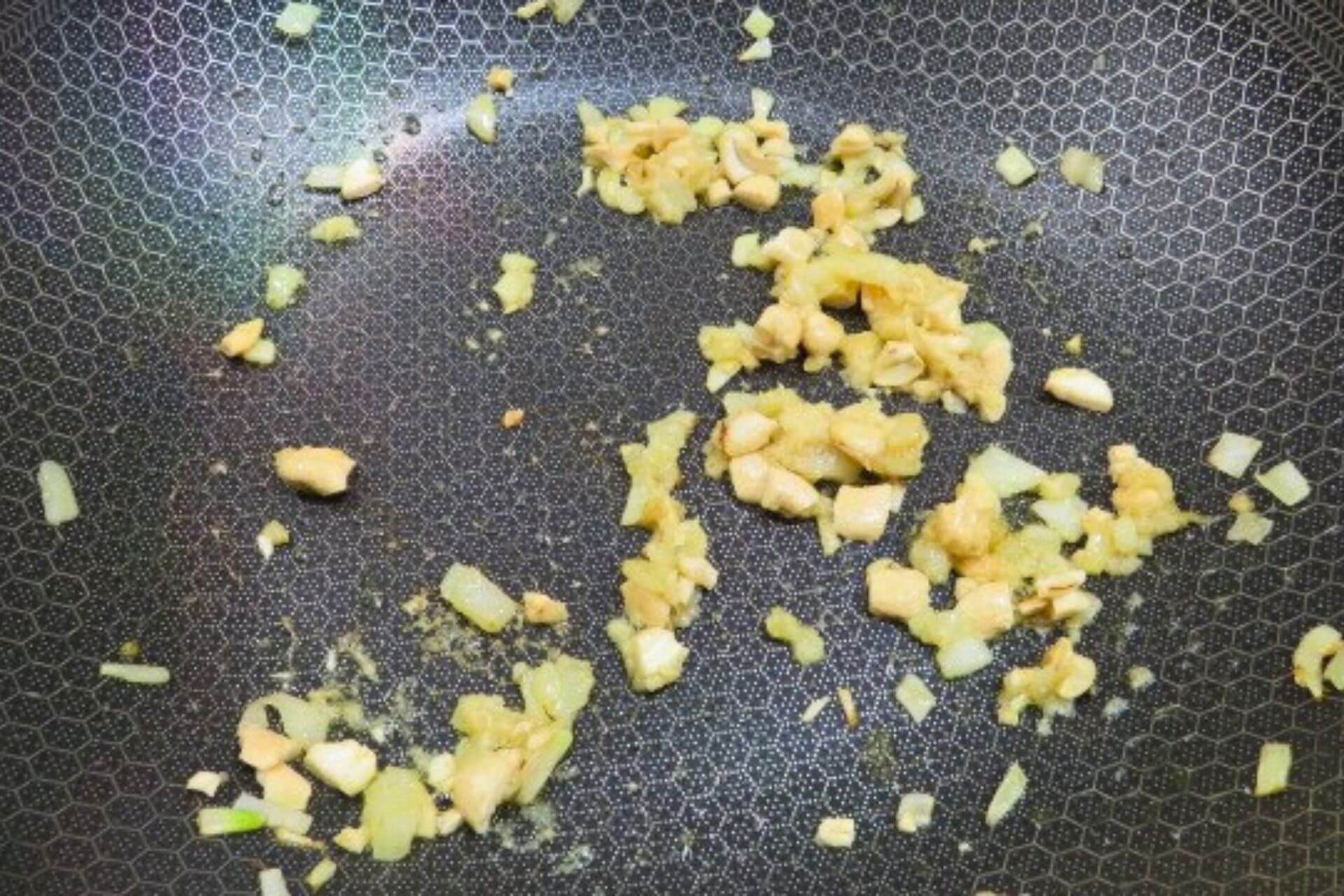
- Add the sweet potato, spices, and salt. Use the spatula to mash the sweet potato and add the peas and cilantro. Turn off the heat once the mixture is dry and add the lemon juice. Let the filling cool.
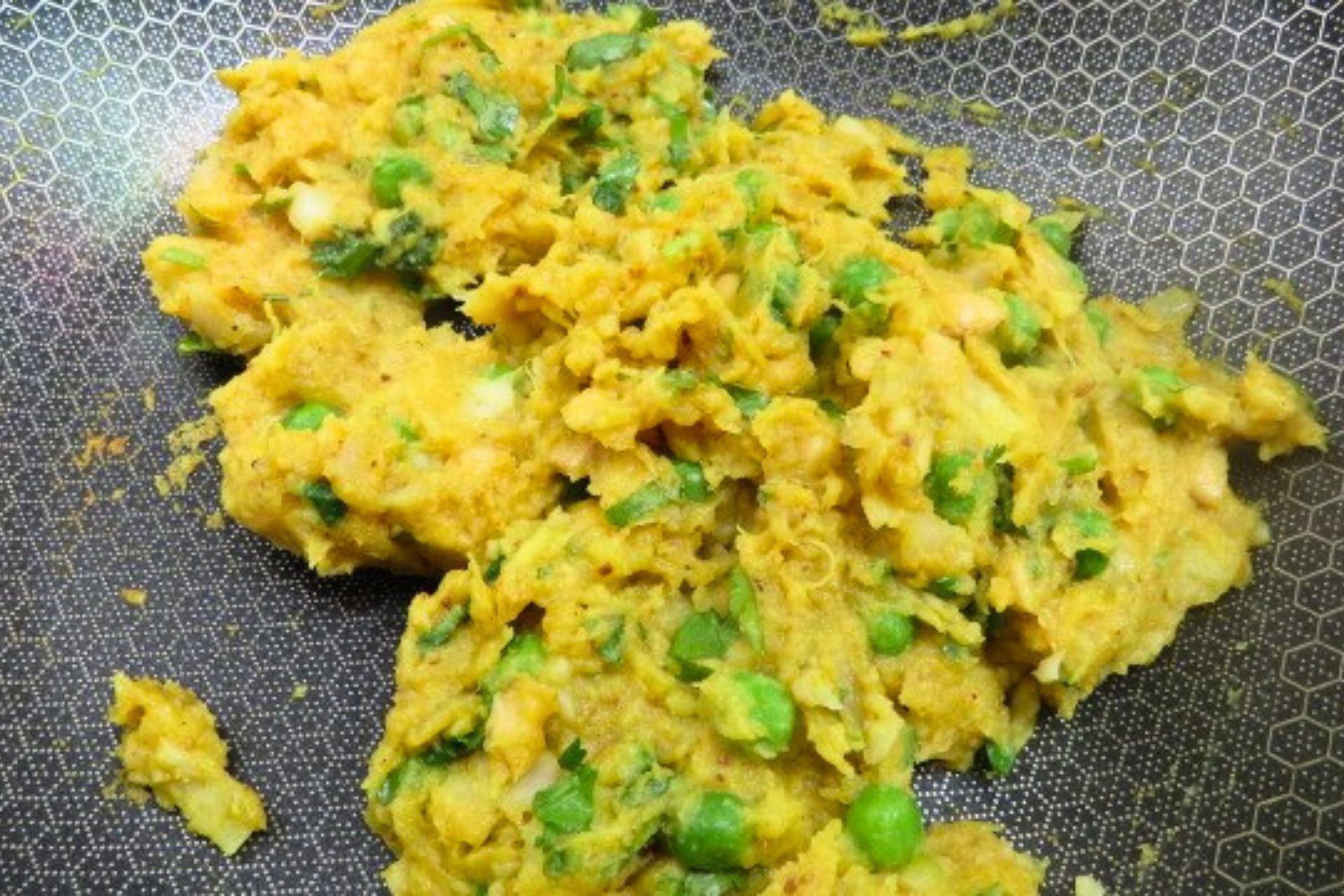
3. How to make the samosas:
- Roll the dough into 6 or 7″ discs. Cut them into halves. Place a scoop of filling in the center.
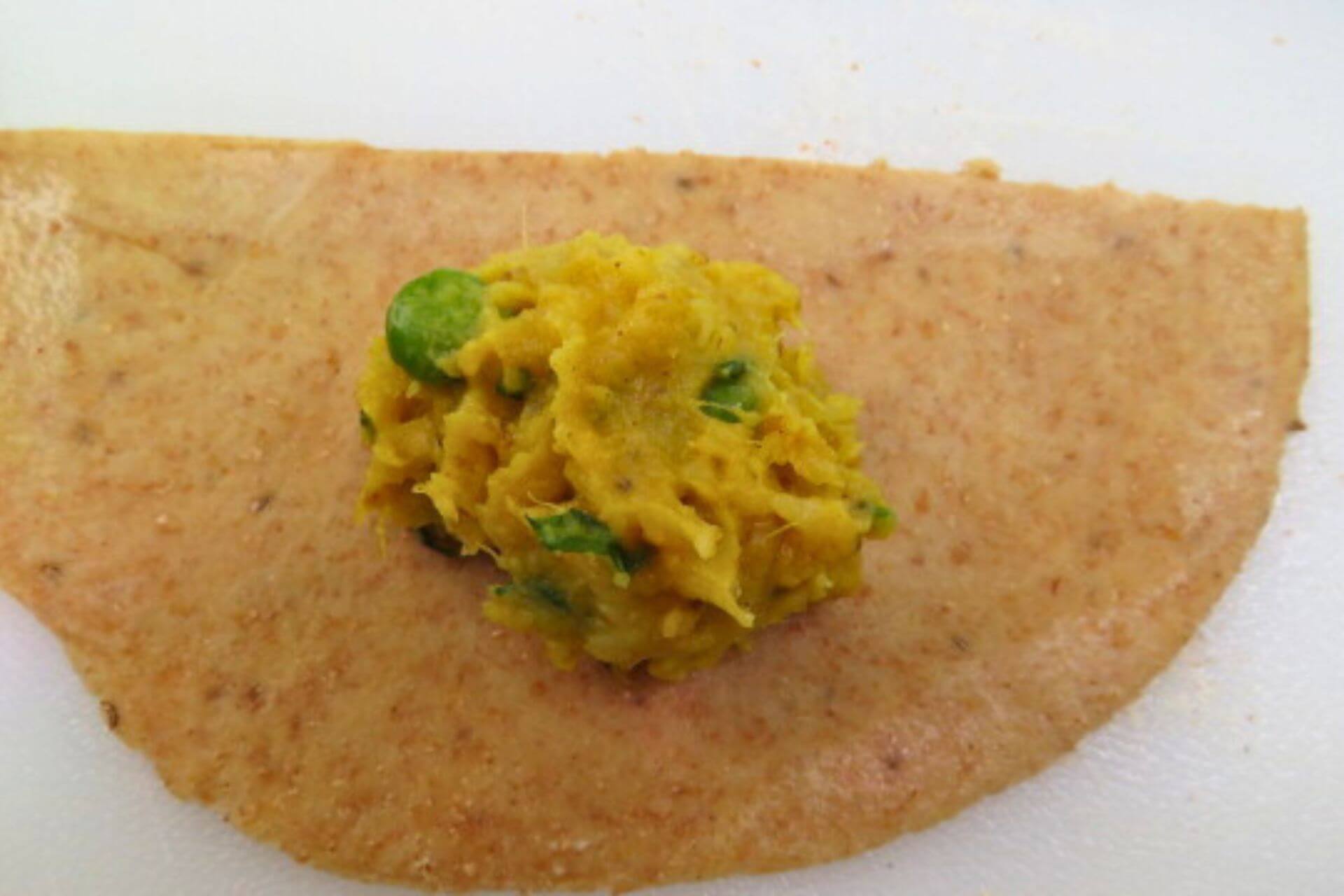
- Bring one end of the flap over the filling. Now place the other end of the flap over the first one. Brush on the inside of the last flap and the opening with a little water.
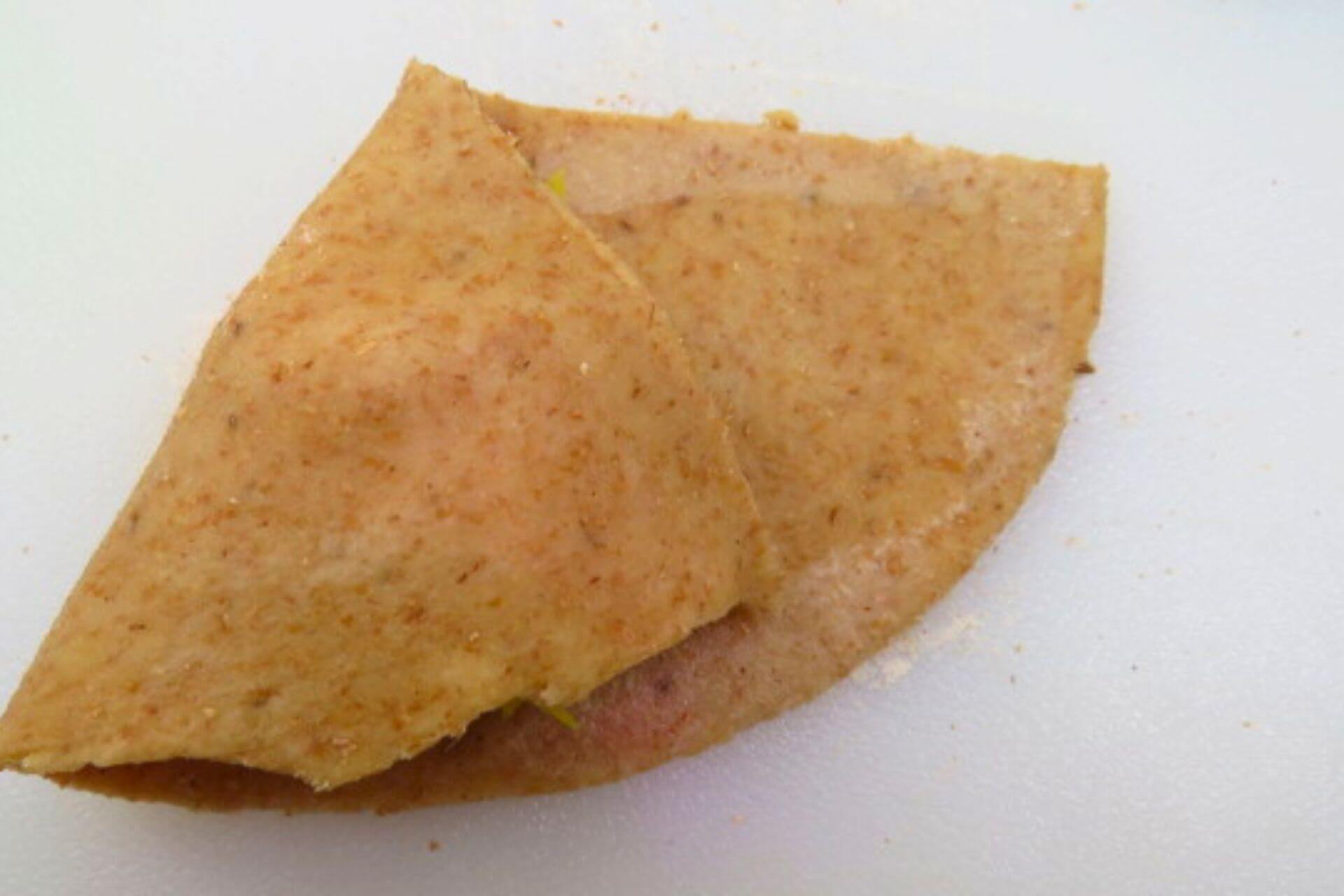
- Seal the edges of the opening firmly, ensuring that the filling is intact. (Refrigerate for an hour after you have rolled out all the samosas, but this step is not necessary). Place the samosas on a foil-lined baking tray. Brush them with olive oil.
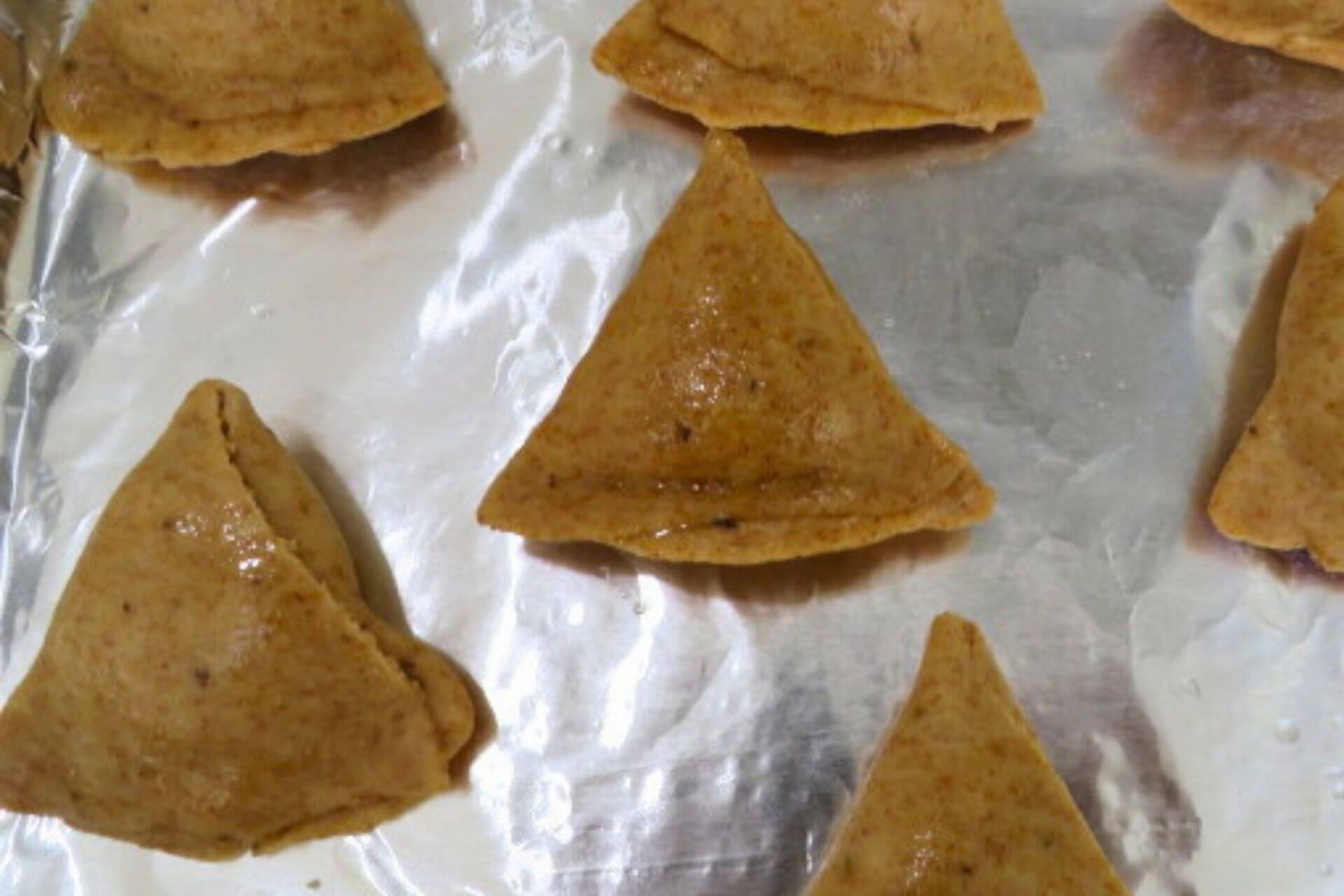
- Bake the samosas at 375 degrees F for 7- 9 minutes. Then flip them over and bake again for 7- 9 minutes or until golden brown. Serve hot with mint and tamarind chutneys.
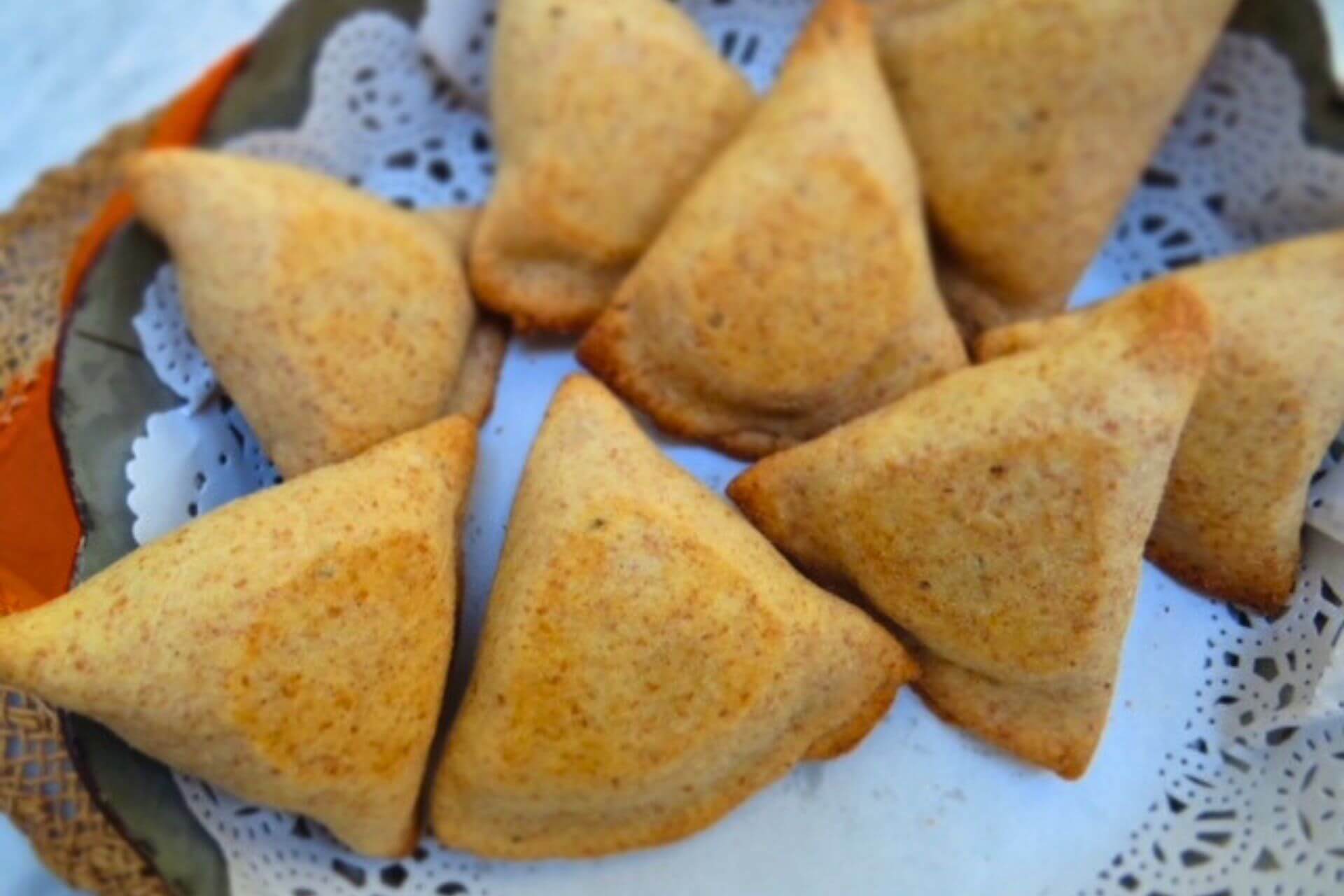
1. Do not roll the discs too thin or too thick but around 1/8 ” thick. Roll them into an even thickness.
2. Try not to stuff too much of the filling.
3. Brush with water only on the inside of the opening of the shell.
4. The pastry dough must be slightly soft yet stiff and firm to the touch.
5. Rub the fats well into the flour until it resembles fine breadcrumbs.
6. Brush some oil on the crust to give the Baked Samosa a crispy exterior.
Serving suggestion:
This recipe for the Baked Samosas is served with Mint Chutney and Tamarind Chutneys.
Storage:
This Baked Samosa recipe is ideal for storing in airtight boxes and refrigerated for a week. Reheat them by baking in an oven on the lowest setting for 6 – 8 minutes after thawing them to room temperature. Microwaving them softens the samosa crust. Baked Samosas can be frozen for three months in freezer-safe containers.
Other baked pastry recipes that you might like:
Baked Samosa Recipe
Equipment
- Food processor, stovetop, oven
Ingredients
For the pastry:
- 1½ cup white whole wheat flour
- 1½ cup red whole wheat flour
- ½ tsp salt
- 1 tsp carom seed
- 2 tbsp clarified butter melted ghee
- ½ cup water ice cold, as needed
For the filling:
- 1 tbsp olive oil
- 1 tsp ginger minced
- 1 onion minced
- ⅕ tsp asafetida powder
- ¼ cup cashew nut chopped
- 1 large sweet potato cooked, peeled
- ¼ cup peas
- ⅕ tsp turmeric powder
- ¾ tsp ground cumin seed
- 1 tsp ground coriander seed
- ½ tsp salt
- ¼ tsp garam masala powder
- 1 tsp lemon juice
- 3 sprig cilantro chopped
- olive oil for brushing
Instructions
How to make the samosa pastry:
- Prepare the ingredients.
- Add the flour, salt, ghee, and butter to the food processor with the dough blade. Run the processor to 'rub' the fat into the flour until it resembles bread crumbs.
- Slowly add ice-cold water as needed or until it forms a firm dough. Let the dough rest for 30 minutes.
How to make the filling:
- Heat a pan with the olive oil. Sauté the ginger with asafetida for a few seconds. Add the onion and cashew nuts and sauté until lightly caramelized.
- Add the sweet potato, spices, and salt. Use the spatula to mash the sweet potato and add the peas and cilantro. Turn off the heat once the mixture is dry and add the lemon juice. Let the filling cool.
How to make the samosas:
- Preheat the oven to 375 degrees F. Roll the dough into 6 or 7" discs on a floured surface. Cut them into halves. Place a scoop of filling in the center.
- Bring one end of the flap over the filling. Now place the other end of the flap over the first one. Brush on the inside of the last flap and the opening with a little water.
- Seal the edges of the opening firmly, ensuring that the filling is intact. (Refrigerate for half an hour after you have rolled out all the samosas, but this step is not necessary). Place the samosas on a foil-lined baking tray. Brush them with olive oil.
- Bake the samosas for 7- 9 minutes. Then flip them over and bake again for 7- 9 minutes or until golden brown. Serve hot with mint and tamarind chutneys.
Notes
- You can air-fry the samosas at 375 degrees for 15 - 18 minutes by following the instructions in the post.
- You could use only all-purpose flour if you prefer.
- The other method of encasing the filling is by making a cone with the half-disc. Place the filling and seal the edges with water.
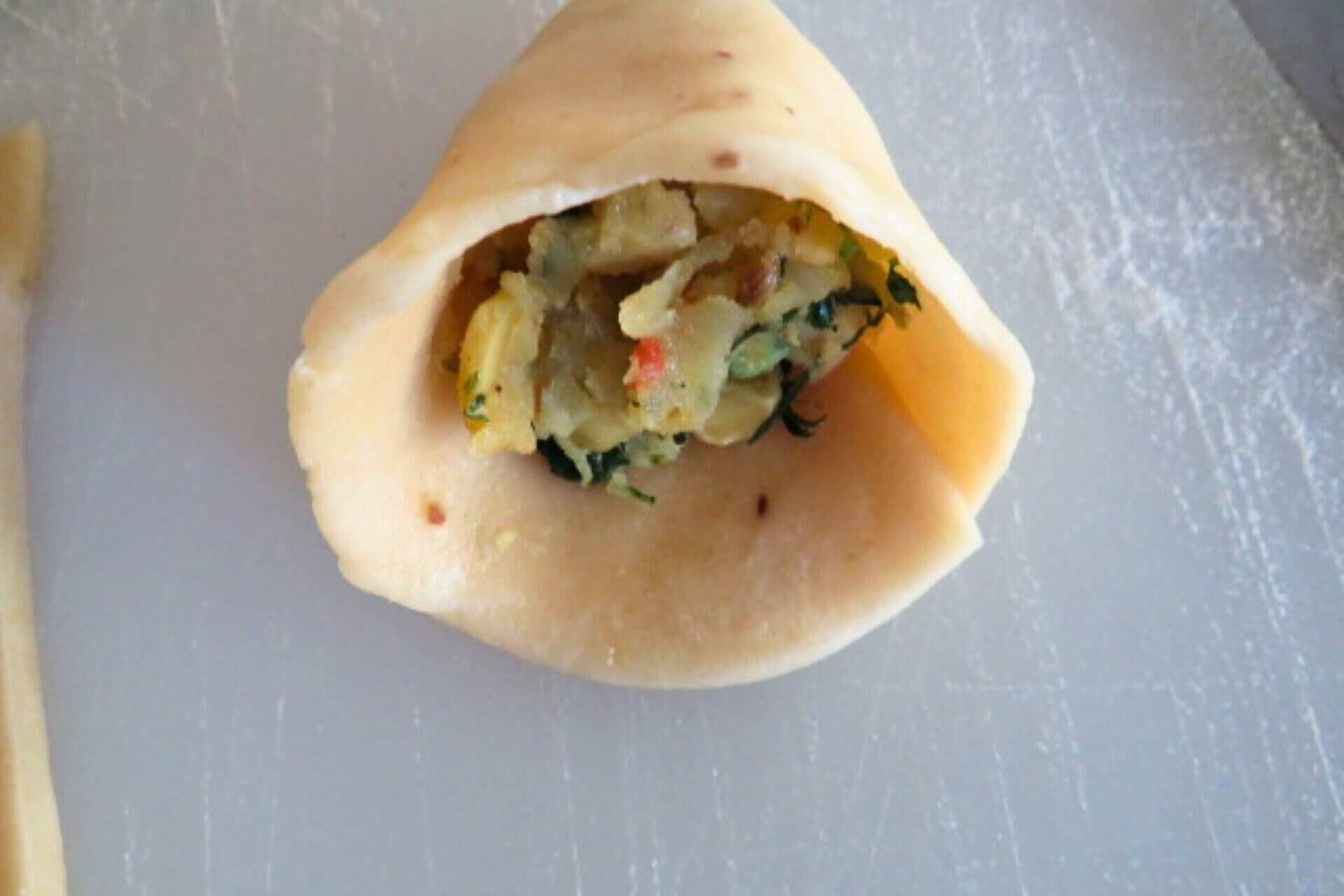
Nutrition


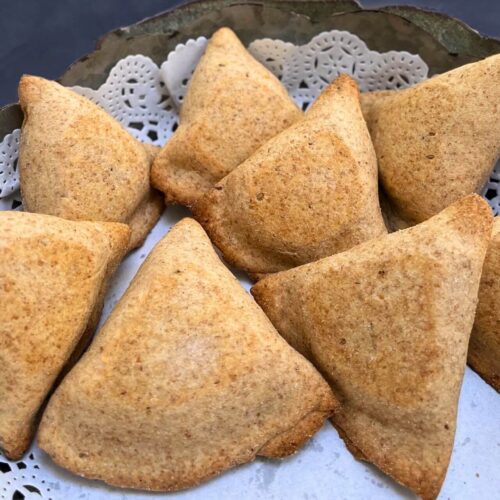
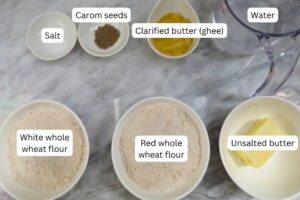
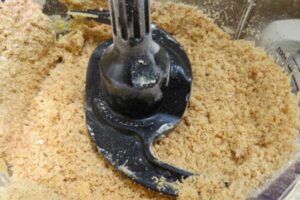

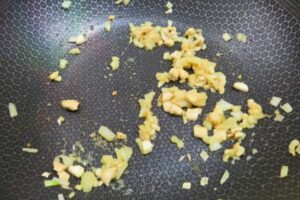
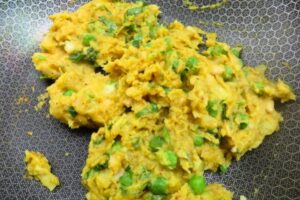
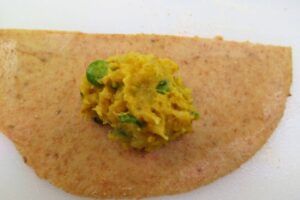
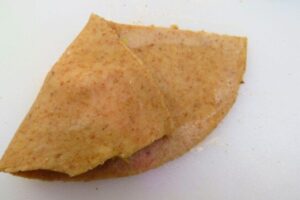
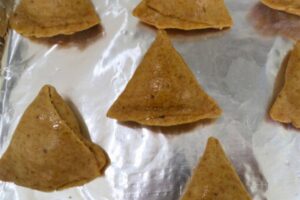
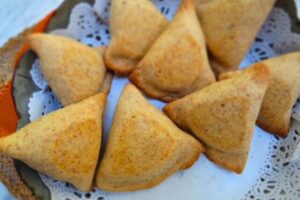




















0 Comments